Queues are a common sight outside the midnight-blue doors of the Antiga Confeitaria de Belém, in the Lisbon riverside district of the same name. Inside this café, some very special pastries are on sale. Only three members of staff possess the secret recipe for the sweet custard tarts produced there since 1837, and they say the bakery in the back produces on average 40,000 of them a day in the peak tourist season. The tarts are called pastéis de Belém or pastéis de nata. They offer light, crispy pastry cupping a silky, vanilla-flavored custard that is slightly charred on top. Each tart comes with miniature sachets of caster sugar and cinnamon to sprinkle over them. And, in their sprinkling, the twenty-first-century customers unwittingly join up more than 500 years of Portuguese history.
The café lies close to the spot from where, during the Age of Exploration starting in the fifteenth century, Portuguese sailing ships that were among the biggest on the seas were seen off on their sometimes years-long voyages. The Portuguese Discoveries delivered a giddy period of milestones in world history. It was a flush of genius and enterprise never witnessed again in Portugal. The Portuguese, wrote the historian Jaime Cortesão in his 1960s work Os Descobrimentos Portugueses (The Portuguese Discoveries), “set in motion a world revolution” by leading Europe out of the Mediterranean and into the Atlantic and beyond, creating new horizons.
Back in Lisbon, it rained money. At least, it did if you were plugged into the intercontinental trade that to a large degree was run as a monopoly by the Crown. The fabulous wealth Portugal harvested during those days of empire was concentrated almost entirely in the capital. Cosmopolitan Lisbon was the place to be if you wanted news or gossip about what was happening across the globe. Portugal went from European minnow to big fish.
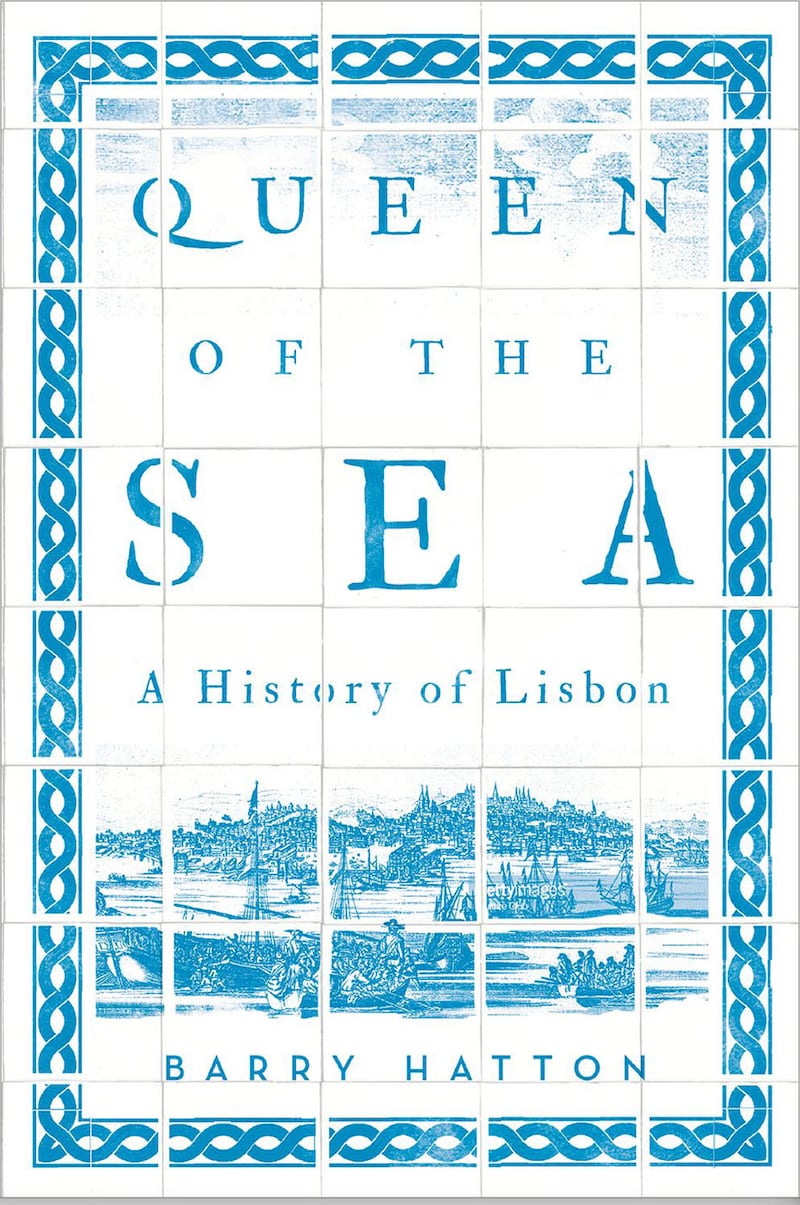
A Portuguese battle fleet that sailed out of the Tagus on 25 July 1415 turned left toward North Africa and its target: Ceuta. The successful attack on that Muslim stronghold was the starting gun for the Age of Exploration. The Portuguese inched down the West African coastline, growing bolder and bolder, until King João II hatched the Plano das Índias (the Indias Plan) later in the fifteenth century. The scope of his ambition was staggering: to divert through Lisbon the trade in lucrative spices from the Orient to Europe. At that time the spices, used by Europeans in cooking and by apothecaries for medicines, came overland to Alexandria and then by sea to Venice, from where they were sold across Europe. This audacious Portuguese monarch wanted to cut out the middle man and bring them from India straight to Lisbon by ship. And he did.
Dreaming big paid off, in a big way. By virtually cornering the European market in goods from the East and Africa, the Portuguese kingdom became cash-rich. Pepper cost the Portuguese two cruzados a sack in Cochin, on India’s west coast, and they sold it in Lisbon for thirty cruzados. With that steep mark-up, Lisbon prospered and a degree of euphoria took hold. The Portuguese were, said the 19th-century Portuguese historian Oliveira Martins, “intoxicated by the scale of the wealth.” Damião de Góis, one of Portugal’s outstanding Renaissance figures who by royal appointment chronicled the reign of King Manuel I, reported that he often saw at the riverside Casa da Índia, where the arriving goods were inventoried and stored, “merchants with bags full of gold and silver currency to make payments [but] officials told them to come back another day because they didn’t have time to count it all.”
The flourishing economy propelled Lisbon’s urban expansion. The city dilated, in buildings and population. Plague, drought and hunger drained the countryside, and peasants converged on the capital in hope that the wealth might trickle down. The population swelled from around 70,000 in 1528 to some 120,000 by the end of that century.
It was a time of plenty for the Catholic Church, too. Lisbon became sown with grand religious monuments.
Convents, monasteries and churches flourished in the city’s soil. By the second half of the sixteenth century, Lisbon had more than a dozen substantial convents and monasteries. The religious orders often grabbed the most prominent hilltop locations, such as Graça, Nossa Senhora do Monte, Santana, Pedreira, São Vicente and Penha de França, and these new buildings gave birth to new neighborhoods in their vicinity. A new architectural scale took hold, exemplified by the immense Hospital Real de Todos os Santos (Royal All Saints Hospital) and the spectacular Jerónimos Monastery.
Vasco da Gama’s 1499 arrival back in Lisbon after two years at sea, during which he found the sea route to India, provided one of the last major royal occasions at St George’s Castle. Caravels went out to meet Gama in the mouth of the Tagus and escorted his two surviving, battered carracks into port. King Manuel and Gama, side-by-side, went on horseback up to the castle as people crowded along the streets and waved from houses.
The castle was their destination, but the king had something else on his mind—something that would change Lisbon forever. He had already set his master plan in motion, clearing land by the river from 1498 onwards. In 1500 construction of a new palace began, and several years later the monarch moved in.
King Manuel I’s decision to abandon St George’s Castle and switch the court to a magnificent new royal palace by the river was a milestone that reflected Lisbon’s deep political, administrative, economic and cultural changes. The move added momentum to the reshaping of the city by shifting its center of gravity from the hilltop down to the river. The relocation also carried a heavy symbolism, pulling back the curtain on a new era that wedded Portugal’s destiny to the sea. The Portuguese monarch went from being a crusading warrior king who had conquered the castle to a trade king who had conquered international commerce.
With its overseas triumphs Lisbon grew in confidence and burst out of its medieval defensive boundaries, spilling into surrounding land. Not everyone was impressed, however. France’s King François I looked down his nose at Portugal’s commercial success. He sniffily referred to King Manuel as Le Roi Mercier (The Grocer King).
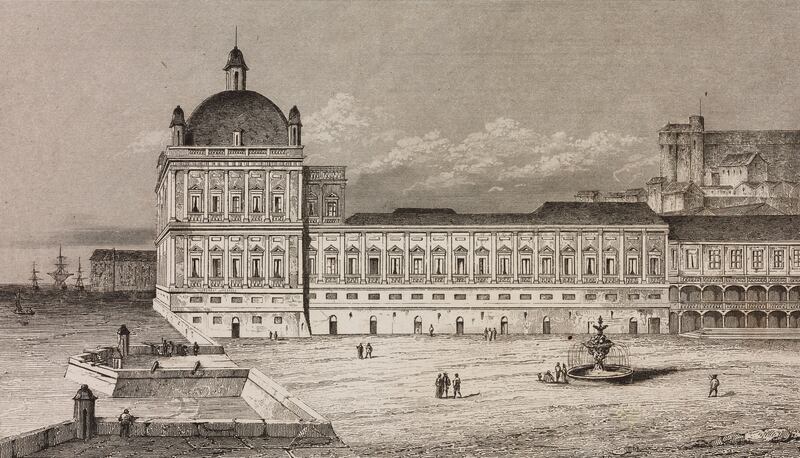
Ribeira Royal Palace, Lisbon, Portugal, engraving by Lemaitre from Portugal, by Ferdinand Denis, L'Univers pittoresque, published by Firmin Didot Freres, Paris, 1846.
De Agostini Picture Library/GettyKing Manuel’s construction of the new palace, called Paço da Ribeira, set off an urban revolution in the early 1500s. It provided a cue for the riverside area, which had been growing in importance since the previous century, to finally take precedence as the city’s commercial and administrative heart.
The palace was “the richest, the most luxurious, the most stunning Portuguese dwelling ever seen,” according to historian Paulo Caratão Soromenho. The building was rectangular, at a right angle to the river and had a stone bulwark over the water. The opulent rooms were on three floors, with arcades at street level. Over the coming years the palace was improved and stocked with sumptuous riches, including rare jewels, great tapestries, works of art by old Masters, a royal library containing some 70,000 books, and an elaborate royal chapel.
The huge space cleared along the riverfront, in addition to the simultaneous landfill operation that reclaimed land from the Tagus in a major engineering operation, was intended for more than just a big new palace. The palace itself occupied the west side of what became known as the Terreiro do Paço (Palace Courtyard), a public area. This broad square still exists and is known as the Praça do Comércio (Commercial Square). The palace’s main entrance, decorated with marble balconies, was on the northern side away from the river. The palace was destroyed in the calamitous 1755 earthquake, which razed much of downtown Lisbon.
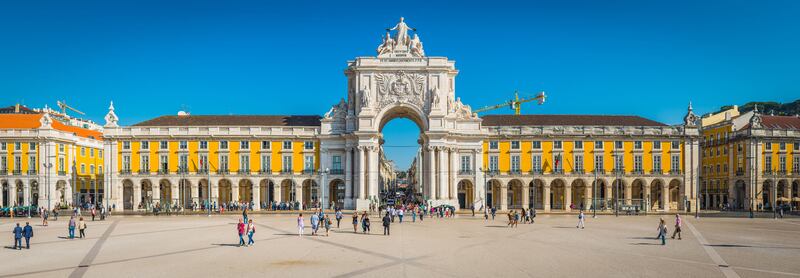
Praca do Comercio
GettyThe area around the palace came to include the India House, the royal mint, the royal armory, royal warehouses and royal shipyards. King Manuel could admire from his window the evidence of his power. This part of the city was the heart of Portugal’s military-industrial complex and ground zero of Portugal’s imperial might. It bore comparison with the Arsenal of Venice, regarded as the most significant centralized production complex of pre-industrial Europe.
King Manuel could watch from his palace the loading and unloading of the ships after he built the Cais de Pedra, a stone quay jutting out into the river from the vast courtyard. He was also close to the Armazéns da Índia (India Warehouse), located on the opposite, eastern side of the square from the palace, which took care of naval logistics and provisioning.
The nerve center for the India operations was right under the monarch’s nose, in the India House. It was set up on the ground floor of the palace and was in charge of the administration and management of trade throughout the empire. Góis described the Casa da Índia as an “emporium of aromas, pearls, rubies, emeralds and other gems that year after year are brought from India.”
But being wealthy wasn’t enough. In Renaissance Lisbon, you had to be seen to be wealthy, and the monarch was no exception. The showiness and pageantry of the royal entourage was legendary.
The first elephants seen in Europe since Roman times were unloaded in the Portuguese capital in the early sixteenth century. These gifts from India for King Manuel performed tricks, bowing on command and blowing water, and delighted the courtiers and the inhabitants of Lisbon. Other arrivals were an African rhinoceros, gazelles, antelopes, monkeys, parrots and a jaguar.
The animals made up the monarch’s cortège whenever he proceeded through Lisbon. Góis described the procession: it was led by the rhino, followed at some distance by five elephants rigged out in gold brocade, then an Arabian horse, the jaguar, and the king and his entourage accompanied by the beat of drums and the fanfare of trumpets.
The exotic animals were kept on the palace’s ground floor, in barred rooms. The king fancied seeing a fight between an elephant and a rhino, so the two were brought together in an interior patio, with members of the court hanging out of the windows to watch the whimsical spectacle. The entertainment was brief, however. The elephant soon turned and ran, smashing through a door and running into the street, eventually reaching Rossio Square several hundred meters away before it came to a halt.
King Manuel wanted the rest of the continent to know about his affluence. In a flamboyant gesture, in 1514 he sent to Rome a white Indian elephant as a gift for the new pope, Leo X. An elephant was a fitting symbol for Portugal and the pontiff, possessing power, longevity and stoutness. The animal certainly made a splash in Renaissance Europe, hungry for novelties. Transported by ship from Lisbon, it took several weeks for the elephant to be led from the Italian coast to Rome, because so many people crowded around to see it. The first elephant in Rome since Hannibal was a great success. Pope Leo X was enthralled by the animal and very fond of it. He named it Hanno, after Hannibal, and Portugal was the talk of the town.
The following year King Manuel sent a 2-ton rhino called Ganda to Rome. It wore a green velvet collar embroidered with golden roses. The ship had to stop off in Marseille so that King François I, intrigued, could see it. The adventure went awry, however, when the carrack was shipwrecked off the Italian coast and the rhino, chained to the deck, died. When it later washed up on shore, King Manuel had it stuffed and taken to Rome anyway. The German artist Albrecht Dürer never saw the rhino, but his woodcut of it became more famous than the animal itself.
The lavish spending extended to projects that were intended to magnify King Manuel’s accomplishments, emphasize his piety and immortalize his reign. It was also an example of the extravagance that absolute power and mega-wealth invite.
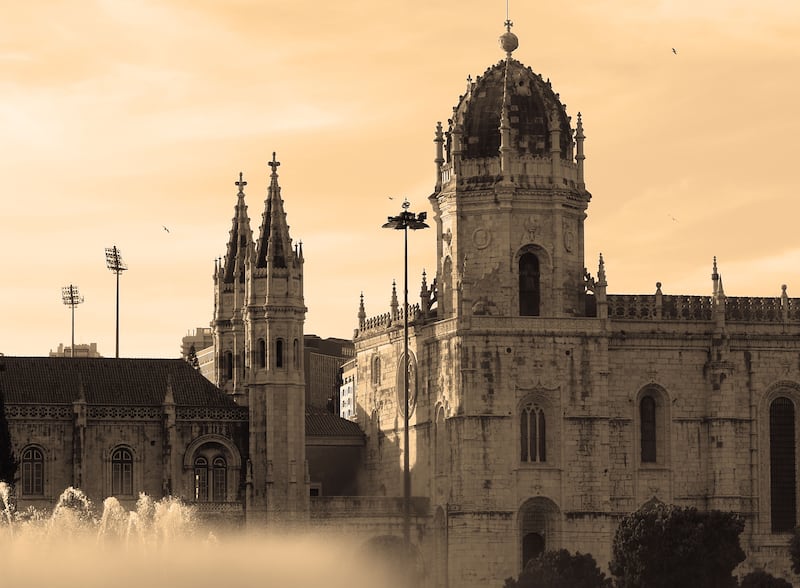
Jerónimos Monastery
GettyThe greatest expression of that temperament was the Jerónimos Monastery, in Belém. It is regarded as a masterpiece of what would later become referred to as the Manueline style of architectural ornamentation. Completed 100 years after it was begun in 1502, the building was the monarch’s biggest prestige project. Having survived the 1755 quake mostly intact, the national monument is one of Lisbon’s signature buildings and one of Portugal’s gems.
After its completion, the Jerónimos Monastery was the city’s most important religious monument. It replaced the monastery at Batalha, about 100 kilometers to the north, as the resting place of royalty.
The building was not intended, as is often claimed, to commemorate Gama’s accomplishments. King Manuel requested the papal bull for its construction in 1495, two years before Gama’s departure for India. The monarch, whose three successive queens were Spanish, named it out of a keenness to bring closer together the neighboring Iberian kingdoms. The Spanish royals were fond of the Order of Jerónimos, and this Lisbon project was intended to be one of twelve Jerónimos Order monasteries in Portugal for which Manuel requested the pope’s blessing. He, like other Portuguese royals, had an elusive dream: a single Iberian country, with a Portuguese monarch at its head.
Belém in those days was little more than a medieval village. The monastery’s scale, muted nowadays by the modern city’s dimensions, was staggering. Artistic renderings of the time show the vast building sitting amid desolate land. Construction began on the symbolic date of 6 January—the Feast of the Epiphany, more commonly known in Iberia as Three Kings’ Day.
Jerónimos was paid for by a generous donation from the Florentine banker and slaver Bartolomeu Marchione as well as a 5 per cent tax levied by the Crown on the trade in spices, gems and gold, known as the vintena da especiaria, pedraria e minas. An old saying had it that Jerónimos was “built by pepper”.
The monastery and its church stand parallel to the Tagus, so that anyone passing on the river can see a lot of its 300-meter length. It fired a cultural broadside, so to speak, at anyone sailing into Lisbon. Then, as now, it was a look-at-me building, with its south-facing walls of local limestone reflecting the sun. Jerónimos sent a message. It said, we are very wealthy and very pious.
The ornate and elaborate Manueline style was inspired by Portugal’s associations with the sea. It is intricate and busy— like the times that gave birth to it. Maritime motifs in stone capture, Medusa-like, the paraphernalia of the adventures, featuring ropes and knots, anchors and navigational equipment, as well as religious flourishes. The enchanting Jerónimos cloisters on two floors are richly sculptured, like stone filigree. Statuettes depict great historical figures. In the south portal, for example, Prince Henry the Navigator is portrayed as bearded and wearing armor and holding a sword and shield. The church’s vaulted ceiling, 25 meters high, is dizzying. Octagonal pillars soar up to the webbed dome. The Guia de Portugal says the effect is less like that of a cathedral than of a giant cave punctuated with stalactites. The stained-glass windows are, disappointingly, from the 1930s.
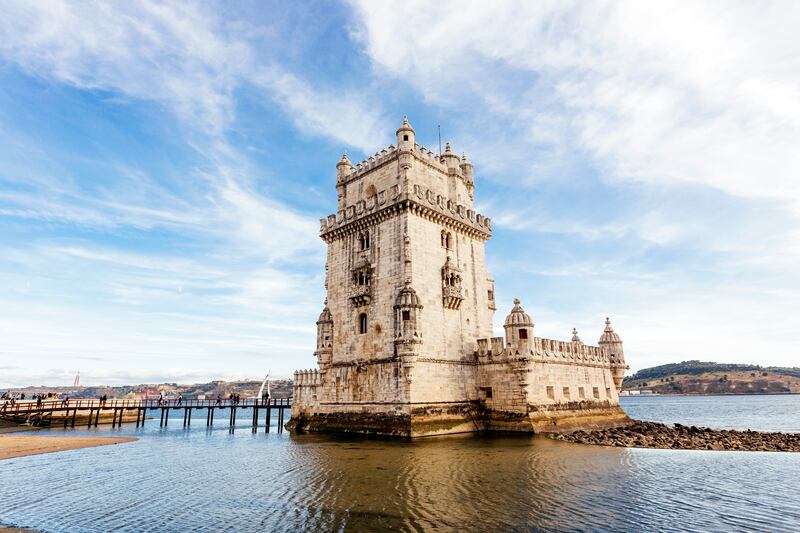
Belém Tower
Alexander Spatari/GettyEqually representative of the Manueline style is the nearby Torre de São Vicente, better known as the Torre de Belém (Belém Tower). This unusual military building rendered in thick blocks of stone was originally 250 meters out into the river and formed part of the Tagus defensive system. Changing currents and sedimentation have filled in the gap to the shore. It is a boxy, odd-looking structure, with two distinct parts: a square tower, in a palatial style with ceremonial rooms and featuring a Venetian-style veranda with river view; and a bulwark with positions for seventeen cannon and a magazine beneath it.
The building, completed in 1521, is utilitarian while capturing in its details a Manueline ornateness, with that style’s Islamic flourishes. Its turrets imitate Koutoubia, the largest mosque in Marrakesh where the man appointed to oversee the Torre de Belém’s construction, Francisco de Arruda, had worked for two years. On the north-west corner, one of the gargoyles is a rhino’s head, thought to represent Ganda.
In sixteenth-century Lisbon, the buzzword among the elite and contemporary authors was “grandeur”. That was the word they wanted associated with the city. After all, what else would a capital of a country with an intercontinental empire merit?
Excerpted from Queen of the Sea: A History of Lisbon by Barry Hatton courtesy of Oxford University Press.

